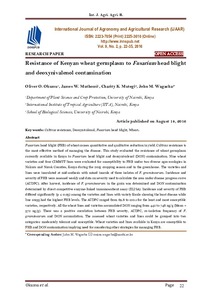| dc.contributor.author | Okumu, O.O. |
| dc.contributor.author | Muthomi, J.W. |
| dc.contributor.author | Mutegi, C.K. |
| dc.contributor.author | Wagacha, J.M. |
| dc.date.accessioned | 2019-12-04T11:04:09Z |
| dc.date.available | 2019-12-04T11:04:09Z |
| dc.date.issued | 2016-08-14 |
| dc.identifier.citation | Okumu, O.O., Muthomi, J.W., Mutegi, C.K. & Wagacha, J.M. (2016). Resistance of Kenyan wheat germplasm to Fusarium head blight and deoxynivalenol contamination. International Journal of Agronomy and Agricultural Research, 9(2), 22-35. |
| dc.identifier.issn | 2223-7054 |
| dc.identifier.uri | https://hdl.handle.net/20.500.12478/1351 |
| dc.description | Article Purchased |
| dc.description.abstract | Fusarium head blight (FHB) of wheat causes quantitative and qualitative reduction in yield. Cultivar resistance is the most effective method of managing the disease. This study evaluated the resistance of wheat germplasm currently available in Kenya to Fusarium head blight and deoxynivalenol (DON) contamination. Nine wheat varieties and four CIMMYT lines were evaluated for susceptibility to FHB under two diverse agro-ecologies in Nakuru and Narok Counties, Kenya during the 2013 cropping season and in the greenhouse. The varieties and lines were inoculated at mid-anthesis with mixed inocula of three isolates of F. graminearum. Incidence and severity of FHB were assessed weekly and data on severity used to calculate the area under disease progress curve (AUDPC). After harvest, incidence of F. graminearum in the grain was determined and DON contamination determined by direct competitive enzyme-linked immunosorbent assay (ELISA). Incidence and severity of FHB
differed significantly (p ≤ 0.05) among the varieties and lines with variety Kwale showing the least disease while line 10155 had the highest FHB levels. The AUDPC ranged from 69.8 to 120.1 for the least and most susceptible varieties, respectively. All the wheat lines and varieties accumulated DON ranging from 442 to 748 ng/g (Mean = 572 ng/g). There was a positive correlation between FHB severity, AUDPC, re-isolation frequency of F. graminearum and DON accumulation. The assessed wheat varieties and lines could be grouped into two categories: moderately tolerant and susceptible. Wheat varieties and lines available in Kenya are susceptible to FHB and DON contamination implying need for considering other strategies for managing FHB. |
| dc.description.sponsorship | Regional Universities Forum for Capacity Building in Agriculture |
| dc.format.extent | 22-35 |
| dc.language.iso | en |
| dc.subject | Deoxynivalenol |
| dc.subject | Wheat |
| dc.subject | Fusarium |
| dc.subject | Germplasm |
| dc.title | Resistance of Kenyan wheat germplasm to Fusarium head blight and deoxynivalenol contamination |
| dc.type | Journal Article |
| dc.description.version | Peer Review |
| cg.contributor.crp | Wheat |
| cg.contributor.affiliation | University of Nairobi |
| cg.contributor.affiliation | International Institute of Tropical Agriculture |
| cg.coverage.region | Africa |
| cg.coverage.region | East Africa |
| cg.coverage.country | Kenya |
| cg.identifier.url | http://www.innspub.net/ |
| cg.authorship.types | CGIAR and developing country institute |
| cg.iitasubject | Disease Control |
| cg.iitasubject | Plant Diseases |
| cg.journal | International Journal of Agronomy and Agricultural Research |
| cg.howpublished | Formally Published |
| cg.accessibilitystatus | Open Access |
| local.dspaceid | 79403 |
| cg.targetaudience | Scientists |

